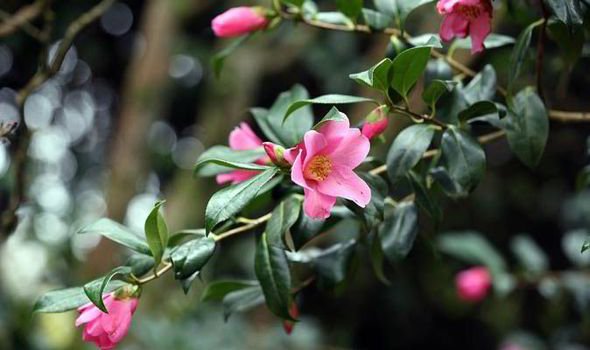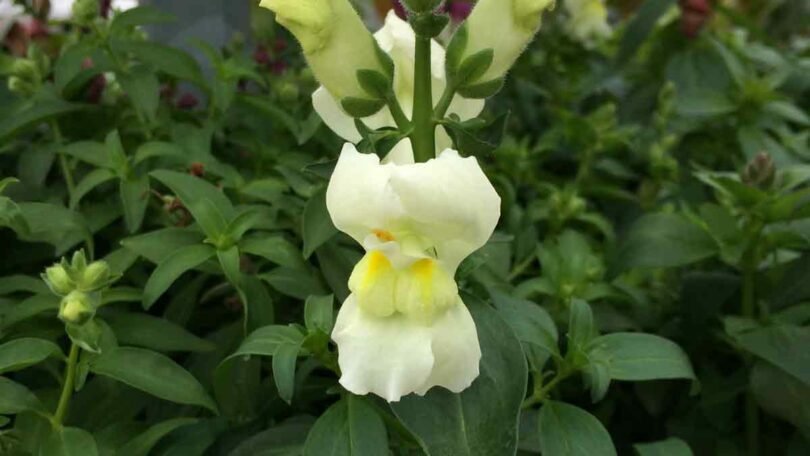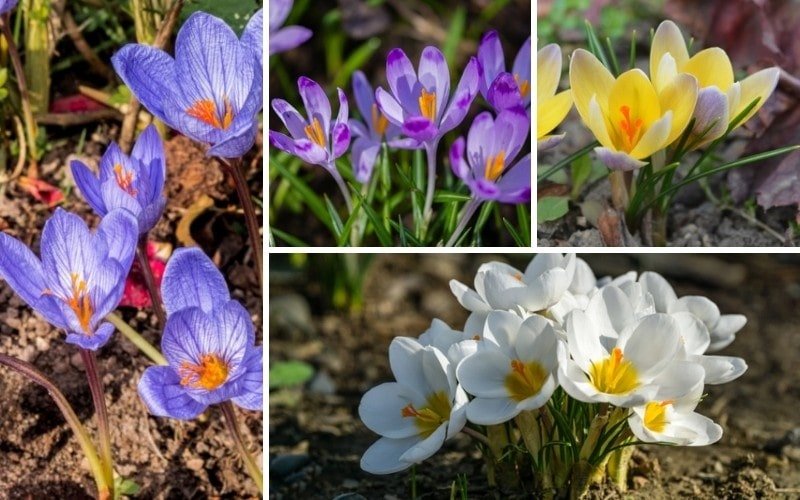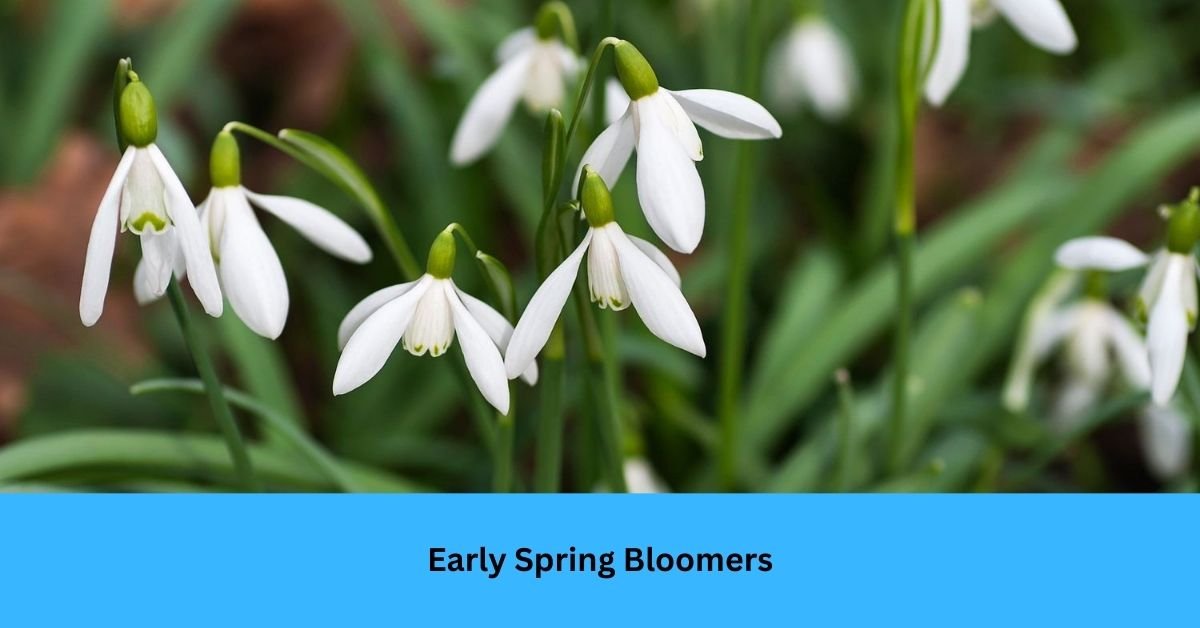As winter ends and spring begins, early spring flowers can add bright colors to your garden. These hardy plants are among the first to bloom, bringing a fresh burst of color.
Here are some top choices to start your garden’s season.
Snowdrops (Galanthus Nivalis)
Snowdrops are heralds of spring, often emerging from beneath the snow as early as January or February.
Their delicate, white, teardrop-shaped flowers dangle from slender stems, creating a striking contrast against the winter landscape.
Growing Conditions
Planting
Snowdrop bulbs should be planted in the fall, ideally about 4-6 inches deep and spaced 4-6 inches apart. They thrive in well-drained soil and can tolerate a range of light conditions from full sun to partial shade.

Care
After planting, snowdrops require minimal maintenance. They benefit from a light fertilization in spring and fall. Once established, they will naturalize and spread over time, providing annual displays.
Zones: 2-9
Lenten Rose (Helleborus)
Despite their name, Lenten roses are not true roses but are evergreen perennials offering winter to early spring blooms. Their flowers resemble old-fashioned roses and come in shades from pristine white to deep pink.
Lenten roses are known for their ability to bloom when the weather is still cold, making them a reliable addition to any early spring garden.
Growing Conditions
Planting
These plants prefer rich, well-drained soil and thrive in partial to full shade. They should be planted in a location where they will receive morning sun and afternoon shade.
Care
Lenten roses are relatively low-maintenance. They benefit from an annual application of a balanced fertilizer in early spring. It is also helpful to mulch around the plants to conserve moisture and suppress weeds.
Zones: 3-9
Pansies (Viola × wittrockiana)

Pansies are well-loved for their bright, colorful blooms and are among the most versatile early spring flowers. They can be planted in early spring or late summer to provide color throughout the cooler months.
Pansies come in an array of colors and patterns, making them perfect for adding a vibrant touch to garden beds and containers.
Growing Conditions
Planting
Pansies are best planted in well-drained soil that is kept consistently moist. They prefer cool temperatures, ideally between 45-65°F. Space them about 6-12 inches apart to allow for their spreading habit.
Care
They benefit from regular watering and a balanced fertilizer applied at planting and again in early spring.
Pansies can survive in most regions, though they may need protection from extreme heat in summer.
Zones: 4-11
Violets (Viola Species)
Violets are another excellent choice for early spring color. These plants are closely related to pansies but generally feature smaller flowers. Violets can tolerate a range of conditions, including frost, making them suitable for cooler climates.
Growing Conditions
Planting
Violets thrive in well-drained soil with a preference for partial shade. They are tolerant of a range of soil types but do best in slightly acidic to neutral conditions.
Care
Violets require minimal maintenance. Fertilize them at planting and again in spring to promote robust growth. They may need watering during dry periods but are generally hardy once established.
Zones: 4-11
Snapdragons (Antirrhinum majus)

Snapdragons are known for their distinctive flower spikes and vibrant colors. They can bloom throughout early spring and into summer, providing a dynamic splash of color. Snapdragons come in various heights and colors, from rich reds to bright yellows.
Growing Conditions
Planting
Snapdragons should be planted in well-drained soil with full sun exposure. They can tolerate light frost but generally prefer cooler weather for optimal flowering.
Care
They benefit from regular watering and a mid-season application of a balanced fertilizer. Removing spent flowers can encourage more blooms and extend the flowering period.
Zones: 9-11
Reticulated Iris (Iris Reticulata)
The Reticulated Iris is one of the earliest irises to bloom, often appearing in late winter or early spring. It features vibrant colors, including blue, purple, and yellow, and is characterized by its small, intricate flowers.
Growing Conditions
Planting
These irises are best planted in well-drained soil in a sunny or partially shaded location. They should be planted about 3-4 inches deep.
Care
Reticulated irises are low-maintenance. They require a light application of fertilizer in the spring and fall. After blooming, the foliage will die back naturally, so no cutting back is needed.
Zones: 5-9
Crocus (Crocus species)

Crocuses are one of the first flowers to bloom in spring, often peeking through the snow. They offer a range of colors, from purple to yellow, and have a charming, cup-shaped flower.
Growing Conditions
Planting
Crocus bulbs should be planted in the fall, about 3-4 inches deep in well-drained soil. They prefer full sun to partial shade.
Care
Fertilize crocuses in the spring and fall. The foliage will die back naturally after flowering, and no additional care is needed until the next growing season.
Zones: 3-8
Winter Jasmine (Jasminum nudiflorum)
Winter Jasmine is a deciduous vine that blooms in late winter, producing bright yellow flowers along its stems. Although it doesn’t have the fragrance of other jasmines, its vibrant flowers are a welcome sight during the colder months.
Growing Conditions
Planting
This plant prefers full sun to partial shade and well-drained soil. It can be grown as a vine or ground cover.
Care
Winter jasmine should be pruned back after flowering to maintain its shape and prevent it from becoming too unruly. Fertilize in early spring to support new growth.
Zones: 6-10
Conclusion:
Early spring bloomers are essential for adding beauty and color to your garden when many other plants are still dormant. By choosing the right varieties and providing appropriate care, you can enjoy a garden filled with vibrant blooms even before the warm weather fully arrives.
Whether you’re planting in garden beds or containers, these hardy flowers will bring joy and a touch of spring to your landscape.
FAQs:
What are the best flowers to plant for early spring color?
The best flowers for early spring include snowdrops, crocuses, pansies, and Lenten roses. These hardy plants bloom early and can thrive even in cooler temperatures.
Can early spring flowers survive frost?
Yes, many early spring flowers like snowdrops, pansies, and hellebores are frost-tolerant and can bloom despite cold temperatures.
When should I plant bulbs for early spring blooms?
Most bulbs for early spring flowers, such as crocuses and snowdrops, should be planted in the fall before the ground freezes to ensure they bloom in early spring.
Do early spring flowers require a lot of sunlight?
While some early bloomers prefer full sun, many, like hellebores and violets, thrive in partial shade, making them suitable for various garden spots.
How can I extend the blooming season of early spring flowers?
To extend the bloom time, choose a mix of early bloomers with different flowering periods, fertilize in early spring, and deadhead spent flowers to encourage new growth.
Can early spring flowers be grown in containers?
Yes, many early spring bloomers, such as pansies and irises, can be grown in containers. Ensure proper drainage and use high-quality potting soil for the best results.
Which early spring flowers are low-maintenance?
Snowdrops, crocuses, and violets are low-maintenance flowers that return year after year with minimal care. They require little more than basic planting and occasional fertilizing.
Are there fragrant early spring flowers?
Yes, some early spring bloomers, like winter jasmine and certain varieties of irises, offer pleasant fragrances, adding another layer of enjoyment to your garden.
Can I combine early spring flowers with other plants?
Absolutely. Early spring flowers pair well with perennials and shrubs, adding pops of color while other plants are still dormant.
What’s the best way to care for early spring flowers?
Water regularly during dry spells, fertilize in early spring, and remove dead or damaged leaves to promote healthy growth and ensure vibrant blooms.





